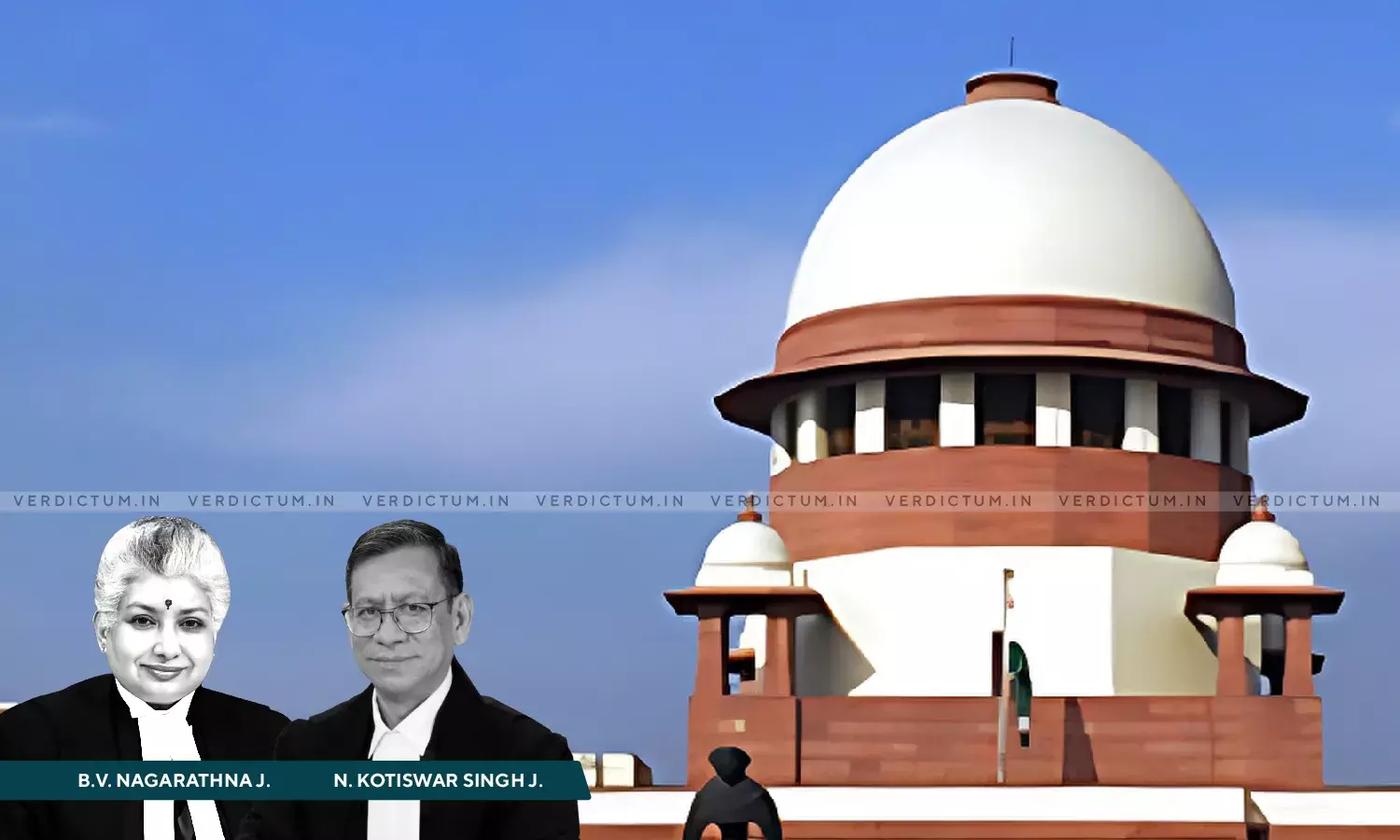Tower & Pre-Fabricated Buildings Are Goods & Not Immovable Property; Qualify As ‘Inputs’ Under Rule 2(k) CENVAT Rules: SC
The Supreme Court held that the tower and pre-fabricated buildings (PFBs) are goods and not immovable property and qualify as ‘inputs’ under Rule 2(k) of the Central Value Added Tax Credit Rules, 2004 (CENVAT Rules).
The Court held thus in a batch of Civil Appeals preferred by M/s Bharti Airtel Ltd. and others against the decisions of the Bombay High Court and Delhi High Court.
The two-Judge Bench comprising Justice B.V. Nagarathna and Justice N. Kotiswar Singh observed, “Having held that the tower and pre-fabricated buildings (PFBs) are “goods” and not immovable property and since these goods are used for providing mobile telecommunication services, the inescapable conclusion is that they would also qualify as “inputs” under Rule 2(k) for the purpose of credit benefits under the CENVAT Rules.”
The core issue involved in the set of Appeals was whether the mobile service providers (MSPs) who pay excise duties on various items for setting up their business more particularly for erection of mobile towers and peripherals like pre-fabricated buildings (PFBs) etc. can take the benefit of CENVAT Rules for the purpose of payment of service tax on the output services rendered by them. With respect to the same, conflicting views were given by two High Courts. The Bombay High Court ruled against the MSPs, favouring the Revenue, holding that MSPs are not entitled to CENVAT credit on mobile towers and prefabricated buildings. Whereas, the Delhi High Court held to the contrary extending the benefit of CENVAT credit to the MSPs.
The decisions of both the High Courts were challenged before the Apex Court by the respective aggrieved parties. In the lead judgment of the Bombay High Court which was challenged before the Court, the Bombay High Court held that mobile towers and other components do not fall within the definition of “capital goods” as defined under Rule 2(a)(A) of the CENVAT Rules, nor are these “inputs” within the meaning of Rule 2(k) and, hence, the MSP is not entitled to CENVAT credit on duty paid on these items.
The Supreme Court in the above regard, noted, “… we are of the opinion that merely because certain articles are attached to the earth, it does not ipso facto render these immovable properties. If such attachment to earth is not intended to be permanent but for providing support to the goods concerned and make their functioning more effective, and if such items can still be dismantled without any damage or without bringing any change in the nature of the goods and can be moved to market and sold, such goods cannot be considered immovable.”
The Court summarised the following principles to determine the nature of the property –
1. Nature of annexation: This test ascertains how firmly a property is attached to the earth. If the property is so attached that it cannot be removed or relocated without causing damage to it, it is an indication that it is immovable.
2. Object of annexation: If the attachment is for the permanent beneficial enjoyment of the land, the property is to be classified as immovable. Conversely, if the attachment is merely to facilitate the use of the item itself, it is to be treated as movable, even if the attachment is to an immovable property.
3. Intendment of the parties: The intention behind the attachment, whether express or implied, can be determinative of the nature of the property. If the parties intend that the property in issue is for permanent addition to the immovable property, it will be treated as immovable. If the attachment is not meant to be permanent, it indicates that it is movable.
4. Functionality Test: If the article is fixed to the ground to enhance the operational efficacy of the article and for making it stable and wobble free, it is an indication that such fixation is for the benefit of the article, such the property is movable.
5. Permanency Test: If the property can be dismantled and relocated without any damage, the attachment cannot be said to be permanent but temporary and it can be considered to be movable.
6. Marketability Test: If the property, even if attached to the earth or to an immovable property, can be removed and sold in the market, it can be said to be movable.
The Court said that “input” in relation to manufacturing of final product would mean not only those which are directly used but also indirectly used not only for manufacture of final product whether contained in the final product or not but also used in relation to manufacture of final product or for any of other purpose.
“… when “input” has been defined with reference to providing output service, the definition clauses does not explain it so elaborately but merely uses the simple expression i.e. “used for providing any output service”, it added.
The Court further elucidated that even if the definition of ‘input’ with reference to output service may not have been explained in an expansive manner as in the case of manufacture of final product under Rule 2(k)(i), the definition of ‘input’ with reference to providing output service under Rule 2(k)(ii) need not be given a restrictive meaning as sought to be done by the CESTAT by holding that tower is not used directly for transmission of signal.
“In our view since the subject matter is same, i.e., what amounts to “input” though the end use is for two different products, one tangible, in the form of final manufactured product, and one intangible i.e., output service, applying similar tests to determine what amounts to “input” would not be impermissible”, it also noted.
The Court clarified that while theoretically antenna may receive and transmit signal without the tower, practically, the same is not feasible and tower is an essential accessory for keeping the antenna at an appropriate height and in a stable position so that there is no disturbance in receiving and transmission of signal and there can be wider coverage of signal. It added that yhe link between antenna and tower is almost inseparable for the effective functioning of antenna for providing mobile telecommunication service and it cannot be said that the nexus between antenna and tower is remote, rather, their relationship is quite proximate and inseparable for proper functioning of antenna.
“… there can be no denying of the fact that there is a close proximity and nexus between their functioning and the ultimate transmission of radio signals which is the output service rendered by the MSPs. Hence, the view of the CESTAT which has not been disturbed by the Bombay High Court does not commend our acceptance”, it concluded.
Accordingly, the Apex Court disposed of the Appeals, upheld the Delhi High Court’s Judgment, and set aside that of the Bombay High Court.
Cause Title- M/s Bharti Airtel Ltd. v. The Commissioner of Central Excise, Pune (Neutral Citation: 2024 INSC 880)
Appearance:
Senior Advocates Arvind P. Datar, Tarun Gulati, Harish N. Salve, AORs Charanya Lakshmikumaran, Mukesh Kumar Maroria, Punit Dutt Tyagi, Mahfooz Ahsan Nazki, B. Vijayalakshmi Menon, E. C. Agrawala, M. P. Devanath, Rashmi Singhania, B. Krishna Prasad, Gurmeet Singh Makker, Santosh Kumar, K. R. Sasiprabhu, Advocates V Lakshmikumaran, Yogendra Aldak, Kunal Kapoor, Neha Choudhary, Ayush Agarwal, Umang Motiyani, Falguni Gupta, Kumar Visalaksh, Udit Jain, Pranav Bansal, Anuradha Dutt, Tushar Jarwal, Rahul Sateeja, Vikrant A. Maheshwari, Raghav Dutt, Pakhi Jain, Mahesh Agarwal, Rishi Agrawala, Sayaree Basu Mallik, Abhinabh Garg, Sarad Kumar Singhania, Yash Singhania, Puneet Agarwal, Yuvraj Singh, Shruti Garg, Amrendra Kumar Singh, Chetan Kumar Shukla, Rahul Bhatt, Hemlat Rawat, Vipin Jain, Shilpa Balani, Vappangi Sai Varaprasad, Bhavuk Agarwal, Raghav Shankar, Vishnu Sharma A S, Vishal Agarwal, and Prakhar Agarwal.












